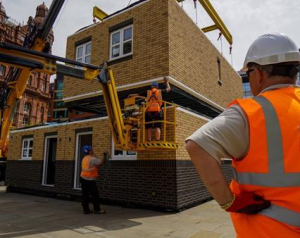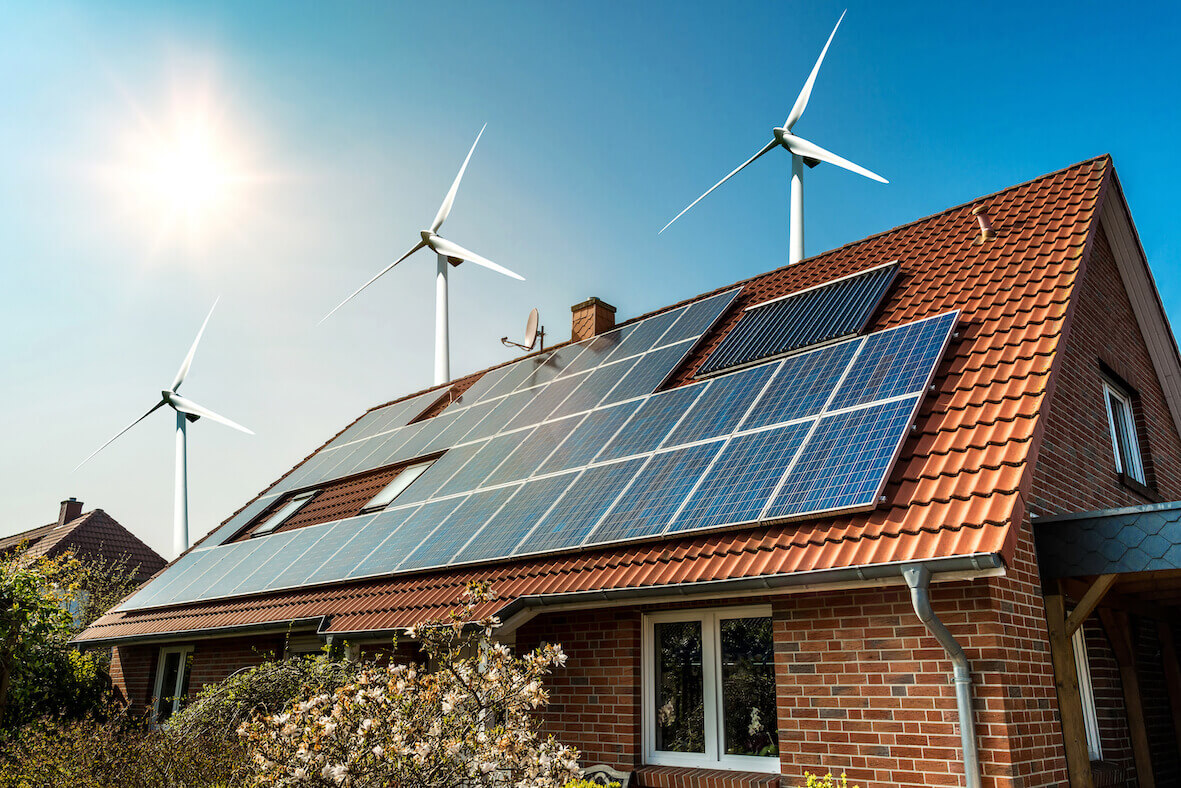What are modern methods of construction?
The housing sector is facing a number of pressures with a drive to meet environmental targets in the way homes are built and the way they’re heated and powered.
We also have a growing population and a challenge to build more homes which meet higher energy-efficiency standards.
Modern methods of construction (MMC) are seen as a way to address both these aims. They offer a fast way of delivering new buildings with greater control over the quality of the components and have been hailed by politicians and developers as a solution not just to the housing crisis but also the climate crisis.

But what do we mean by MMC?
MMC is a broad term to describe the evolution of building techniques from so-called conventional methods such as brick and block to modern systems which may include elements of prefabrication or innovative construction materials or techniques.
It may involve one or more of the following elements: off-site manufacture, off-site assembly, innovative systems constructed on-site, or temporary ‘factories’ producing components on-site.
Factory-controlled processes are better at providing the quality required for high-performance components such as airtight and insulated walls, floors, and roofs. They are also better able to employ recycled building materials and reduce building waste created on-site.
So as well as providing better performing building fabric, MMC is helping housebuilders meet their own net-zero ambitions by enabling more environmentally friendly ways of working.
Modern methods of construction are becoming an increasingly common sight on building sites and self-build projects.

Types of MMC
Panel systems, for example, structural panels of wall, floor and roof cassettes which are produced in a factory and assembled on site. They may be ‘open’ panels or ‘frames’ which comprise the skeletal structure only, with services, insulation, cladding and finishing done on-site. ‘Closed’ panels include the linings and insulation and may also include pre-installed services, windows, and internal and external finishes. The frames may be constructed of light gauge steel, timber, aircrete panels, or structurally insulated panels (SIPs). SIPs comprise a panel of insulation which is sandwiched between two layers of racking board, typically plywood, oriented strand board (OSB) or a composite board.
Volumetric modules or pods may be rooms or whole storeys which can be fully fitted with services which just need ‘plugging in’ or may be left open for on-site fit-out. They may incorporate circulation space in apartments or whole floors in houses. Mini volumetric pods such as bathrooms can be structurally stacked and loaded. Modules or pods may be used as part of a hybrid system, for example, an apartment block with a traditional central core and ground floor podium with volumetric sections added into place.
Onsite MMC includes, for example, insulated concrete formwork, where cast-in-situ concrete is set between two layers of reinforced insulating material, often polystyrene panels. Once the concrete has been poured, the panels remain in place to act as thermal insulation. Thin joint blockwork is a type of onsite MMC where highly engineered blocks can be cemented together using very thin joints. This can speed up construction time and improve the airtightness and thermal performance of the wall. Some modern oak-framed buildings can be classified as MMC where oak posts and beams provide the frame and insulated panels are used to form the walls and roof.
MMC: What do you need to know?
Homes built using modern methods of construction present a number of questions for homeowners, surveyors, and mortgage lenders. What warranties are in place? How can different types of construction be identified, or altered? And what might the implications be for property values?
A highly energy-efficient new MMC property may look very appealing, particularly from an environmental standpoint. As energy performance continues to be driven up the agenda, homes that are already highly performing may benefit from improved marketability.
However, today’s property owners demand many things from their homes, including the ability to alter them and extend them as circumstances change. One limitation of many MMC systems is that it is not always possible to take out a wall here and add an extension there. How this may affect future values will only become apparent when there is a sufficient body of second-hand sales to provide the evidence one way or the other.
A brief history of prefabrication
System building in the UK became widely used in the 20th-century housing boom in the interwar and postwar periods. Councils were under pressure to provide housing for those returning from the First and Second World Wars. A shortage of bricks and bricklayers resulted in the use of steel, concrete and timber. Redundant arms factories were repurposed to manufacture building components, for example prefabricated reinforced concrete walls, which were erected on site.
Then, as now, prefabrication was seen as a solution to a housing need. Speed of delivery was the priority, and many homes were not designed with a long lifespan, notwithstanding that many are still standing today. However, defects began to emerge with certain types of concrete systems resulting in many being designated defective under the 1984 Housing Defects Act. The resulting bad press gave system building, in general, a poor reputation for decades thereafter.
It meant that until relatively recently, the use of innovative forms of construction was largely confined to individual self-build projects.
However, system-building is again taking place on a larger scale and is being adopted by volume housebuilders and housing associations as well as smaller design and construction outfits.
Legal and General has invested millions of pounds in a factory producing precision-engineered timber frames which can be installed with fittings prior to delivery to site. It says the ability to maintain rigorous quality standards enables it to manufacture very airtight homes which achieve an EPC rating of A. (legalandgeneral.com/modular-homes/, accessed 15 November 2021)
Housebuilder Countryside has opened several factories producing both open and closed-panel timber frames. It has set a target that 50percent of all its homes will be built using MMC by 2025. It says that the improved fabric efficiency will reduce carbon emissions from the homes it builds, as well as contributing to the company’s own net-zero carbon strategy. (Countryside says MMC will be at centre of net zero plan, Building magazine, 5 November 2021)
Modular pods have been used in the construction of hotels and student accommodation for some time but are also increasingly being used in housing developments.
However, just as interwar and postwar prefabrication resulted in unforeseen defects, so some modern methods may be at risk of storing up problems for the future. Fire safety organisations have raised concerns about the safety of buildings using modular construction, particularly high-rise blocks. Each modular unit can be surrounded by voids, which can be a serious fire hazard if the modules are built from combustible material and fire stops are not correctly installed.
Once constructed, it is nearly impossible to tell if fire stops have been correctly installed and even if you could, it would be very difficult to undertake any remedial work. Furthermore, where modules depend on internal linings such as plasterboard for some of their fire resistance, this can be seriously compromised if unknowing occupiers make alterations or install sockets, for example, without the correct fire safety rating. Concerns by the London Fire Brigade, the Fire Brigades Union and the Fire Protection Association were put to the then Ministry for Housing, Communities and Local Government (now the Department for Levelling Up, Housing and Communities) by Property Week magazine. An MHCLG spokesperson said: “Increasing the supply of houses remains an absolute priority for this government and modern methods of construction can help deliver good-quality new-build homes faster and more efficiently, with less waste. All homes must meet building regulations and fire safety standards.” (Are we sleepwalking into another Grenfell?, Property Week, 24 September 2021)
Case studies
Leeds Climate Innovation District MMC is a fundamental part of a low-carbon community development in Leeds city centre.
Developer Citu claims its houses and apartments in the Leeds Climate Innovation District use 7 to 10 times less energy than a conventional dwelling. The homes are built from airtight timber panels manufactured in Citu’s nearby factory where they are fitted with recycled glass wool insulation.
They feature triple-glazed windows, solar panels and MVHR (mechanical ventilation and heat recovery) systems. Green roofs keep the buildings cooler in summer and warmer in winter, and there are electric radiators for very cold days. The heating demand is so low that excess solar-generated electricity is fed into a community grid to charge shared electric cars.
Citu says: “The home retains heat so effectively that a gas boiler is no longer required. Its heating needs are so low they can be met with 100 percent renewable energy, preventing the emission of over two tonnes of CO2 per year.” It adds: “Design, sustainability, innovation and technology can all come together to create mixed use urban developments that will help us all accelerate the transition to zero-carbon cities.”
(citu.co.uk, accessed 2 February 2022)


Greencore Construction at Springfield Meadows
Carbon-negative homes are being part-built in a factory for a housing development in Oxfordshire. That means they take out more carbon from the atmosphere than is used to build them.
The closed-panel timber-frame walls are insulated with a hemp and lime mix in a factory before being transported to the site for assembly. The homes are fitted with integrated PV panels with battery storage, triple-glazed windows, and MVHR systems, and are built to exceed Passivhaus standards.
Manufacturer Greencore Construction believes this is a key way to target climate change.
Whereas a conventional house may use about 50 tonnes of carbon in the construction phase, these houses are climate positive, it said.
Greencore boss Ian Pritchett said: “If we start building things with bio-based materials that perform better and have low carbon footprints, we can start to make a serious difference to climate change.”
(greencoreconstruction.co.uk, accessed 21 February 2022)
Scaled-up steel-frame production in Yorkshire
Ilke Homes manufactures steel-frame homes at its factory in Knaresborough, North Yorkshire. The walls are insulated with mineral wool, while a drained cavity skin creates a ‘warm frame’. The roofs are created from timber trusses also insulated with mineral wool. It claims that with solar panels and an air source heat pump, the homes can be zero carbon and cost less than £1 a day to heat.
The company claims it can supply homes from factory order to deliver within 12 weeks, compared with the 26-plus weeks it could take to deliver a traditionally constructed house.
Operating at scale, the factory has a capacity of 2,000 homes a year. The company is also on a schedule to ensure the homes will be zero carbon, with zero energy bills, by 2030.
(ilkehomes.co.uk, accessed 21 February 2022)



